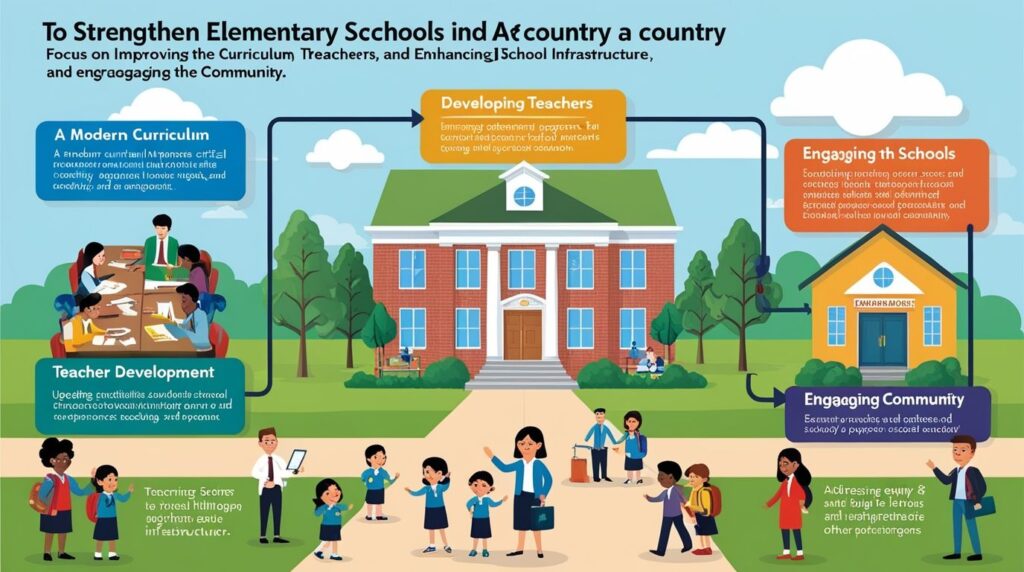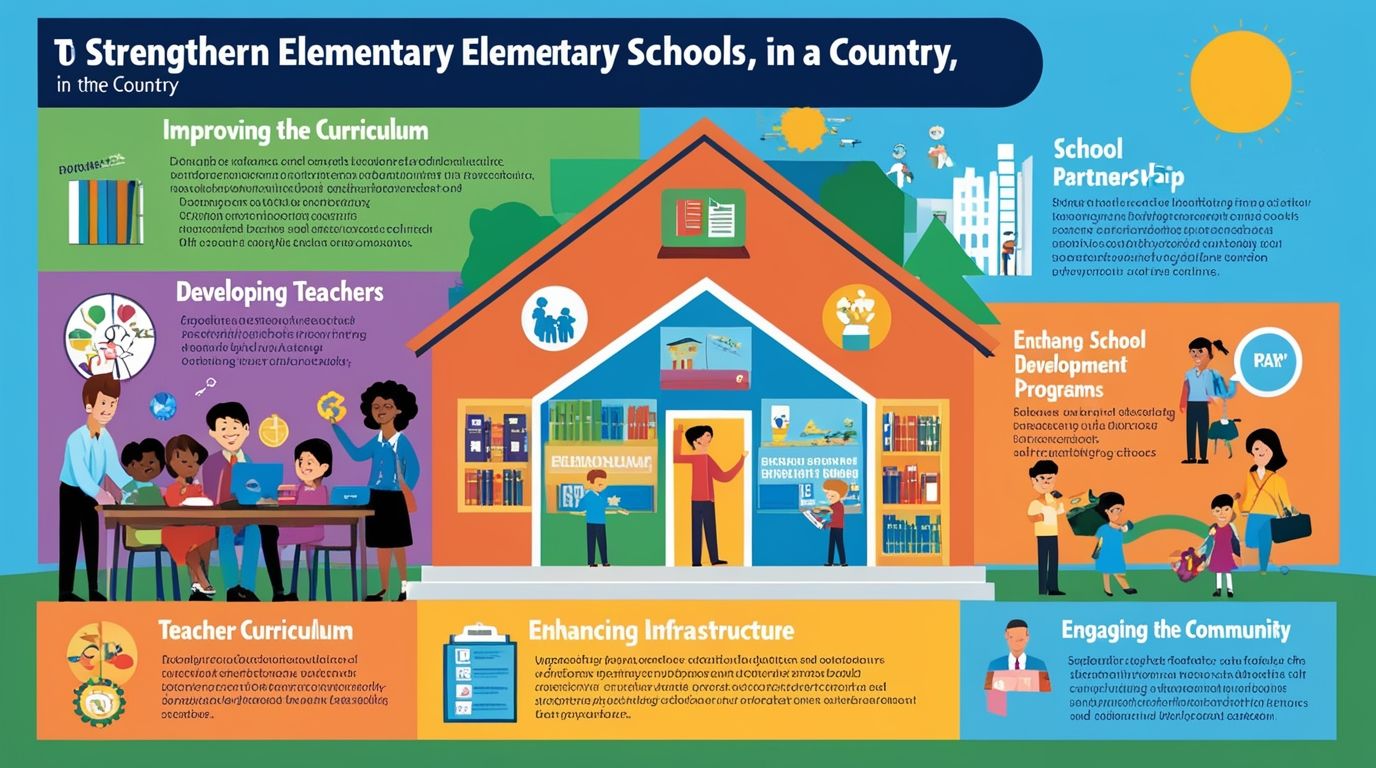Strengthening Elementary Schools in a Country, Education is the cornerstone of societal development, and elementary schools serve as the foundation for a child’s academic journey. Strengthening elementary education is critical in nurturing the cognitive, social, and emotional development of young children. A robust elementary education system equips students with the skills and knowledge necessary for future success and contributes to long-term national growth and stability. This article outlines a comprehensive approach to strengthening elementary schools, focusing on four key areas: curriculum improvement, teacher development, infrastructure enhancement, and community engagement.
1. Curriculum Improvement
A well-structured, relevant, and balanced curriculum is essential for the holistic development of children. The curriculum should align with both national educational goals and the global skills required in the 21st century.
a. Curriculum Modernization
To keep pace with rapid technological advancements, elementary schools must offer a curriculum that fosters critical thinking, creativity, and problem-solving. Traditional subjects like mathematics, science, and language arts should be integrated with new disciplines such as computer literacy and digital citizenship. Moreover, the curriculum should include lessons in emotional intelligence, social responsibility, and environmental awareness to produce well-rounded individuals.
b. Inclusive and Flexible Content
Recognizing diverse learning needs and backgrounds is essential in designing a curriculum that caters to all students. This involves offering adaptive learning pathways for children with disabilities, gifted students, and those from socio-economically disadvantaged backgrounds. Differentiated instruction, along with the integration of multicultural perspectives, will ensure that every student feels represented and has access to a high-quality education.
c. Focus on Lifelong Learning Skills
Elementary schools should emphasize skills that foster lifelong learning, including critical reading, problem-solving, collaboration, and digital literacy. Integrating project-based learning (PBL) and inquiry-based learning (IBL) into the curriculum will help students apply their knowledge in real-world contexts, thus strengthening their ability to think critically and creatively.
2. Teacher Development
Teachers are the most influential factor in the quality of education. To strengthen elementary schools, the recruitment, training, and professional development of teachers must be prioritized.
a. Teacher Recruitment and Retention
Recruiting qualified teachers is a fundamental step in providing quality education. It is essential to create attractive career opportunities and competitive salary packages that encourage talented individuals to enter and remain in the teaching profession. Governments and educational institutions should also promote teaching as a respected and rewarding career path by offering scholarships and incentives for teacher training programs.
b. Continuous Professional Development (CPD)
Providing ongoing training for teachers is crucial in adapting to new teaching methods and curriculum changes. CPD programs should focus on pedagogical techniques, subject matter expertise, classroom management, and technology integration. Mentorship programs that pair novice teachers with experienced educators can also play a significant role in fostering growth and confidence.
c. Teacher Well-being
Teacher well-being is often overlooked, yet it directly impacts their effectiveness in the classroom. Schools should create environments that support teachers’ mental and emotional health, providing access to counseling services and stress-relief activities. Additionally, reducing class sizes and administrative burdens can alleviate stress, enabling teachers to focus on delivering quality education.
3. Infrastructure Enhancement
The physical environment of a school greatly influences the learning experience. Schools that are well-equipped and properly maintained foster a positive atmosphere for both students and teachers.
a. Safe and Welcoming Learning Spaces
Every school should offer safe, accessible, and welcoming environments that stimulate learning. This includes well-lit, ventilated, and temperature-controlled classrooms. Schools should also ensure accessibility for children with disabilities by providing ramps, elevators, and appropriate classroom accommodations. Furthermore, facilities should promote inclusivity, offering gender-neutral restrooms and playgrounds designed for children of all abilities.

b. Access to Learning Resources
Elementary schools must be equipped with up-to-date textbooks, teaching aids, and technology to provide a modern learning experience. Digital resources such as computers, tablets, and interactive whiteboards can facilitate interactive learning and access to a wealth of information. A well-stocked library is also essential in encouraging reading and independent learning.
c. Maintenance and Upgrades
Regular maintenance and upgrades to school facilities are crucial in ensuring they remain conducive to learning. Governments and school administrators should prioritize budgets for repairs and technological upgrades. In areas with extreme weather conditions or limited resources, schools should be designed to withstand environmental challenges while maintaining a positive learning environment.
4. Community Engagement and Support
Building strong ties between schools and communities ensures a holistic approach to education. Community involvement can create a supportive environment for students, enhance school resources, and promote accountability.
a. Parental Involvement
Parents play a critical role in their child’s education, and schools should actively engage with them through regular communication and involvement in school activities. Parental participation in Parent-Teacher Associations (PTAs), school governance, and volunteer programs can strengthen the connection between home and school. Additionally, schools should offer parent education workshops on supporting children’s learning at home and fostering a positive attitude toward education.
b. Partnerships with Local Organizations
Partnerships with local businesses, non-profits, and government agencies can provide schools with additional resources and expertise. These collaborations can offer students opportunities for extracurricular activities, mentorship, and real-world learning experiences. Community organizations may also support schools by providing funding, equipment, or volunteers for specific projects.
c. Fostering a Culture of Accountability
A culture of accountability among educators, parents, and community members ensures that schools are held to high standards. This can be achieved through regular performance evaluations, transparent decision-making processes, and community-driven initiatives that monitor school quality. Public reporting on school performance can also motivate improvements and drive accountability at all levels.
5. Addressing Equity and Access
Ensuring equity and access to quality education for all children is a fundamental goal of any elementary education system. Inequities in access to education, often exacerbated by poverty, gender, and geography, can create long-term disparities in opportunities for children.
a. Closing the Digital Divide
The COVID-19 pandemic highlighted the importance of digital learning, but it also exposed the digital divide. Many students in rural or low-income areas lack access to the internet and digital devices, making it difficult to engage in remote learning. Governments and private organizations should work together to provide affordable internet access and digital tools for students, especially those in underserved communities.
b. Eliminating Barriers to School Enrollment
Free and compulsory education laws must be enforced to eliminate barriers such as child labor, early marriage, and gender-based violence that prevent children, especially girls, from attending school. Additionally, governments should provide financial support for school supplies, uniforms, and meals to alleviate the economic burden on low-income families.
c. Focus on Marginalized Groups
Special attention should be given to marginalized groups, including ethnic, refugees, and children with disabilities, ensuring that they have access to quality education. Schools should implement inclusive practices, offer additional academic support, and ensure that the curriculum is culturally sensitive and accessible.
Conclusion
Strengthening elementary schools requires a multi-faceted approach that focuses on curriculum improvement, teacher development, infrastructure enhancement, and community engagement. By modernizing the curriculum, investing in teacher recruitment and professional development, improving school infrastructure, and fostering community involvement, countries can ensure that all children receive a high-quality education. Additionally, addressing issues of equity and access is essential for creating an inclusive and fair educational system. When elementary education is strengthened, it lays the foundation for a brighter future, contributing to personal success, societal growth, and national progress.
References
- Darling-Hammond, L. (2020). The Flat World and Education: How America’s Commitment to Equity Will Determine Our Future. Teachers College Press.
- Fullan, M. (2021). Leading in a Culture of Change. Jossey-Bass.
- UNESCO. (2021). Global Education Monitoring Report 2021/2: Non-state actors in education: Who chooses? Who loses?
- World Bank. (2022). Education at a Glance: Educational Attainment and Student Performance in Developing Countries.

4 thoughts on “Strengthening Elementary Schools in a Country”
Comments are closed.